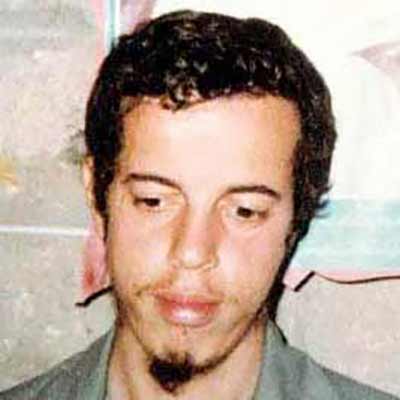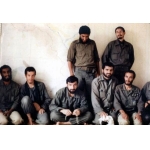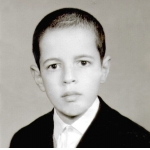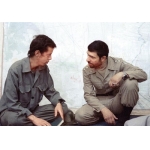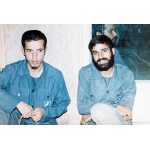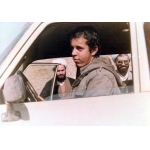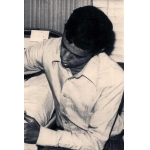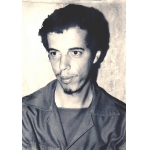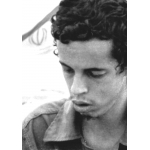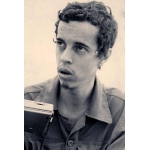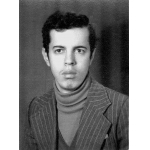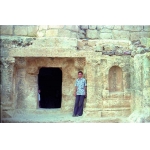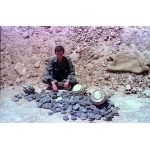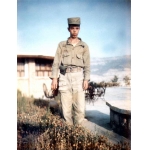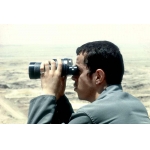Baqeri, Hasan
Fatemeh Khademi
475 بازدید
Qolamhossein Afshordi, also known as Hasan Baqeri, was one of the commanders of the Islamic Revolutionary Guard Corps (IRGC) and the Deputy Commander of the IRGC Ground Forces. He was martyred on January 29, 1983, while conducting reconnaissance on enemy positions in the Fakkeh–Chazabeh axis.
Qolamhossein Afshordiwas born on March 16, 1956, in Tehran. He attended Marvi High School and actively participated in cultural and religious activities at Sadriyeh Mosque in Khorramshahr Square[1]. In 1976, he obtained a diploma in mathematics and subsequently took the nationwide university entrance exam. His results allowed him admission to the Animal Science Program at the University Urmia. Unfortunately, his academic journey was cut short as he was expelled just after three semesters due to his involvement in religious and political activities. In late April 1978, he was conscripted into military service and sent to the Jeldian barracks in Piranshahr, and subsequently to Ilam.[2]
During this time, the Pahlavi regime proposed restrictions on freedom of the press. Afshordi, writing under the pseudonym Hasan Afshar, contributed an article to the Kayhan Newspaper, which was published on October 5, 1978.[3] Afshar, on orders of Imam Khomeini (ra), deserted the barracks on December 2, 1978. After the victory of the Islamic Revolution, he briefly served at the Islamic Revolution Committee of Sadriyeh Mosque[4] before returning to Ilam on March 1, 1979, to complete his military service.[5] In the spring of 1979, Afshordi earned a diploma in humanities and gained admission to the judicial law program at the University of Tehran. Prior to entering university, he joined the editorial team of the newly established Jomhouri Eslami Newspaper.[6]
In the same year, Baqeri traveled to Algeria as part of a delegation that included Mahdi Bazargan, Ebrahim Yazdi, and Mustafa Chamran. Their purpose was to attend celebrations of Algeria’s Independence Day. His report on the event was subsequently published in the Jomhouri Eslami Newspaper on November 3, 1979.[7]
Afshordi was introduced to IRGC intelligence officer Mohsen Rezaee by Ayatollah Khamenei[8], the then editor-in-chief of the Jamhouri Eslami Newspaper. Afshordi adopted the codename “Hasan Baqeri” as he began working for the IRGC intelligence unit.[9]
In addition to writing news and reports for the newspaper, he was tasked with preparing reports for the IRGC. His first report, dated April 27, 1980, on the Tabas incident[10], was titled “Details of the U.S. Military Assault” and printed on the first page of the Jomhouri Eslami Newspaper.[11]
In the mid-1980, he traveled to Lebanon as a reporter affiliated with the Jomhouri Eslami Newspaper to cover the political, social, and cultural situation of the country.[12]
With the onset of the Iran-Iraq War, Baqeri, along with Saeed Sadeqi, the newspaper photographer, headed to Ahvaz.[13] Mohsen Rezaee introduced him to Ali Shamkhani, the then-commander of the IRGC of Khuzestan.
The creation of the IRGC Intelligence-Operation Unit was the result of his activities in the Ahvaz branch of the IRGC.[14] The first official task he initiated at the IRGC in Ahvaz was the preparation of daily reports about the war fronts. He then began training and organizing intelligence units in the regions under the jurisdiction of the IRGC of Khuzestan. Notably, he authored the first confidential bulletin detailing the 24-hour situation on the war fronts. This report was then disseminated to the IRGC and army officials and commanders.[15]
On September 29, 1980, the war headquarters shifted outside the city of Ahvaz (Gulf)[16]. [HR1] Baqeri set up a room – initially called the Map Room – that featured maps of the Khuzestan frontlines. In this space, he meticulously tracked reconnaissance reports and marked the positions of both Iraqi and Iranian forces. Over time, this room became known as the War Room.[17]
On November 11, 1980, he authored a comprehensive report for the country’s officials, detailing the reasons behind the army’s failures in repelling the enemy’s aggression. This report also analyzed the disarray within the Iranian forces during the initial fifty days of the war.[18]
Following the siege of Bostan and Susangerd, and in response to Imam Khomeini’s command that “Susangerd must be liberated by tomorrow”, a meeting was held on November 16, 1980. In this meeting high-ranking national and military officials were present. It was here that Baqeri’s precise intelligence played a pivotal role in liberating Susangerd.
Within three months of the war’s outbreak, Baqeri’s strategic insights, remarkable intelligence capabilities, and problem-solving acumen earned him recognition. Consequently,[19] he was appointed as one of the deputies of the Southern Operations Headquarters.[20]
On May 21, 1981, the Army executed Operation Imam Ali (as) relying on Baqeri’s input. His suggestion to close the enemy’s rear routes in Allah Akbar Hill, north of Susangerd, led to the complete encirclement of enemy forces.[21]
During the Operation Supreme Commander-in-Chief that was conducted on June 11, 1981, after the injury of Seyyed Yahya Rahim Safavi, the operations commander, Baqeri assumed command. Despite heavy enemy assaults in the Western Karun region, the Iranian forces managed to capture and secure the area.[22]
On August 12, 1981, he married Parvin Daeepour, an active member of the Sisters’ Resistance Headquarters of the IRGC of Ahvaz.[23] Their daughter Narges was born in November 1982.[24]
During Operation Thamen al-Aemmah (as), conducted on September 27, 1981, Baqeri was the intelligence operations officer of the Southern Operations Headquarters.[25] He was also one of the commanders serving in the Darkhyon axis. He suggested that the oil company spills a large quantity of black oil into the Karun River. When the oil ignited, the resulting smoke obstructed the view of Iraqi forces. His plan led to the swift capture of the Haffari Bridge in Eastern Karun, the fall of enemy positions in Eastern Karun, and the lifting of the siege of Abadan.[26]
In 1981, Hasan Baqeri, Rahim Safavi, and Gholam Ali Rashid were introduced by Mohsen Rezaee, the Commander-in-Chief of IRGC, as the IRGC’s Planning Group.[27]
Six months before Operation Tariq al-Qods which was conducted on November 29, 1981, Baqeri had carried out intensive reconnaissance missions in the Bostan region and west of Susangerd. He frequently visited the Nabaeh Dunes in the northern part of Bostan, which extended to Northern Chazabeh. He was seeking a way to cut off the enemy’s rear at Chazabeh simultaneously with the operation’s commencement. When the operation began, the enemy was caught off guard in the northern axis at Chazabeh Pass. Iranian forces entered Bostan a few hours later. On the third day of the operation, Baqeri, who had gone to the Sabeleh Bridge to assess the situation, had a car accident due to severe sleep deprivation (72 hours without rest) and was injured. The operation successfully concluded mid-December 1981.[28]
On February 6, 1982, the Iraqi army launched an attack on Chazabeh. On February 19, while still recovering from his injury, Baqeri went to Nabaeh in the eastern suburbs of Bostan and, using available information, maps, and photos, developed a strategy called Operation Moula al-Motaqiyan (as). This operation began on February 20, 1982, with four IRGC battalions and achieved victory after approximately two weeks.[29]
Baqeri devised the final plan for Operation Fath al-Mobin based on the information on the enemy’s position and formations. This operation, which was conducted on March 22, 1982, led to the destruction of Iraq’s 1st Mechanized Division, the capture of the Reqabiyeh pass, and the fall of the Abu Salibi Heights.[30]
By the time of Operation Beit al-Muqaddas on April 30, 1982, Hasan Baqeri expanded the IRGC’s combat organization to twenty brigades after there were only twelve during Operation Thamen al-Aemmah (as).[31]
At the Karbala Headquarters, it took him twenty days to brief other commanders on how Operation Beit al-Muqaddas would lead to liberating Khorramshahr.[32] During this operation, which began on April 30, 1982, he commanded the Nasr Headquarters. By encircling the enemy and preventing their advance in Shalamcheh, the forces under his command set the stage for the enemy’s complete encirclement, leading to their expulsion and the liberation of Khorramshahr.[33]
In Operation Ramadan, which began on July 13, 1982, Baqeri commanded the Nasr Headquarters. The Iraqi army diverted water into the Mahi Canal, which extended from the Kot-e-Suwari outpost to the Bobiyan outpost, blocking the routes and preventing the operation’s success. Hasan Baqeri believed the shortage of troops was the main reason for the failure of the operation.[34] Afterwards, he was appointed by Mohsen Rezaee as the commander of the Karbala Headquarters and was entrusted with managing the war fronts in the south.
Through precise reconnaissance and assessments conducted by Hasan Baqeri in the operational zones, Operation Moslem ibn Aqil was successfully executed on October 5, 1982.[35] This resulted in the liberation of the western region of Sumar.
Operation Muharram, under Hasan Baqeri’s command, took place on 1-3 November 1982, in the Ayn Khosh and Zubeidat regions. As a resulti Iranian forces captured 500 square kilometers of the occupied land and parts of Iraqi territory.[36]
The victories in Operations Moslem ibn Aqil and Muharram diverted the enemy’s focus from the Basra region; however, Hasan Baqeri’s strategic vision focused on Baghdad, the capital of Iraq. For this reason, he and his intelligence team conducted reconnaissance missions in the Iraqi cities of Amarah, Faw, and Ali Gharbi. In the meantime, he also established the Foreign Intelligence Unit, whose members were Iraqi combatants who later formed the Badr Brigade and Division.[37]
Following Operation Muharram, Baqeri was appointed as the deputy commander of the IRGC Ground Forces in the southern headquarters. That same year, although he was to go to Mecca for Hajj, he canceled the trip due to the ongoing war.[38]
On January 29, 1983, while conducting reconnaissance for the preliminary Operation Valfajr, Hasan Baqeri was martyred near the Fakkeh-Chazabeh region by an enemy mortar strike.[39] The military commanders held a funeral ceremony for him at Dezful Airport. In addition, a public funeral and burial ceremony was then held in Tehran. He was laid to rest in Section 24 (the section for commanders) of Behesht-e Zahra Cemetery.[40]
On September 27, 1989, the Leader of the Revolution posthumously awarded him the Fath Medal, and he was elevated to the rank of Major General.[41]
The Hasan Baqeri Memorial Committee opened in 2002, focusing on preserving his legacy.[42] The committee has published several of his works including daily war reports (five volumes), daily war notes (one volume), and personal journals (one volume).[43]
In 2012, a ten-episode documentary titled “Winter Days”, directed by Muhammad Hossein Mahdavian, was produced to depict the impactful and decisive 28 months of Hasan Baqeri’s participation in the Iran-Iraq War.[44] On October 28, 2016, a memorial for Hasan Baqeri was built in Fakkeh where he had been martyred.[45] Numerous books have been published about his life and pivotal role in the Sacred Defense period, including Molaqat dar Fakkeh (Meeting in Fakkeh)[46], Cheshm-e Jebheha (The Eye of the Frontlines)[47], Chashm-e Bidar Hamaseh (The Vigilant Eye of the Epic)[48], Revayet-e Zendegi (The Life Narrative)[49], Rooz-Nevesht (Personal Journals)[50] etc.
[1] Allamian Saeed, Meeting in Fakkeh: Biography of Martyr Hassan Bagheri (Qolamhossein Afshordi), Tehran: Surah Mehr, 2017, pp. 17, 18, 22.
[2] Ibid., pp. 35 and 37
[3] Ibid., P. 42
[4] Ibid., pp. 45 and 52
[5] Dehghan, Ahmad, Notes, Tehran: Shahid Hassan Bagheri Works Publishing Center, 2015, p. 16.
[6] [6] Allamian Saeed, Meeting in Fakkeh, pp. 52, 53 and 55.
[7] Ibid., P. 60
[8] In 1979, Ayatollah Seyyed Ali Khamenei was a member of the Revolutionary Council, the Friday Imam of Tehran, and one of the founders of the Islamic Republic Party. (Encyclopedia of the Islamic Revolution, Vol. 2, Tehran: Surah Mehr, 2010, p. 131.).
[9] Allamian Saeed, Meeting in Fakkeh, pp. 78 and 79.
[10] Secret US military operation in the Tabas desert in 1980, April, 25 to rescue hostages who were captured after the capture of the US embassy (a spy den) by Muslim Student Followers of the Imam's Line
(may Allah have mercy on him). (Saeed Allamian, Meeting in Fakah, pp. 62 and 64.)
[11] Ibid., P. 64
[12] Dehghan, Ahmad, Notes, Tehran: Shahid Hassan Bagheri Works Publishing Center, 2015, p. 93.
Allamian Saeed, Meeting in Fakkeh, p 69.
[13] Allamian Saeed, Meeting in Fakah, p. 80; Shahed Yaran, vols. 91-90, April and May 2013, p. 31.
[14] Allamian Saeed, Meeting in Fakkah, pp. 81-83.
[15] Ibid., p. 87.
[16] A place that the Americans had built for playing golf before the revolution, which became a golf base with the start of the imposed war and was an important center for directing, organizing, and commanding the war until the end of the war. (Saeed Alamian, Meeting in Fakkah, p. 88.)
[17] Ibid., pp. 88 and 103.
[18] Ibid., p. 115.
[19] Ibid., pp. 117, 118, and 121.
[20] The testimony of the Companions, ibid., p. 138. 31.
[21] Allamian Saeed, Meeting in Fakah, pp. 139 and 140; Aslanpour, Samira, Cheshm-e Jebheha (The Eye of the Frontlines), Tehran: Congress to Commemorate Generals of the Revolutionary IRGC and the 36,000 Martyrs of Tehran Province, 1997, p. 54.
[22] Allamian Saeed, Meeting in Fakkah, pp. 141-143.
[23] Ibid., pp. 149, 158, and 160.
[24] Witness of the Companions, ibid., p. 58.
[25] Izadi, Yadollah, Calendar of the Iran-Iraq War, Book 15: Breaking the Siege of Abadan, Tehran: Sacred Defense Documents and Research Center, 2017, pp. 24 and 1007.
[26] Ibid., pp. 1019 and 1020; Allamian Saeed, Meeting in Fakkeh, pp. 164, 168, and 169; Aslanpour, Samira, Eyes of the Fronts, p. 69.
[27] Allamian Saeed, Meeting in Fakkeh, p. 173
[28] Ibid., pp. 174, 175, and 184-181; Sarmadi, Saeed, Martyr Hassan Bagheri: Commanders of the Sacred Defense, Tehran: Sacred Defense Documents and Research Center, 2011, pp. 92 and 93.
[29] Allamian Saeed, Meeting in Fakkeh, pp. 189 and 199-196.
[30] Ibid., pp. 201 and 202; Aslanpour, Samira, Eyes of the Fronts, pp. 83, 85; Sarmadi, Saeed, Hassan Bagheri Martyr: Commanders of the Sacred Defense, p. 95.
[31] Dehghan, Ahmad, Notes, p. 33.
[32] Habibi, Abolghasem, Diary of the Iran-Iraq War, Book Nineteen: The Liberation of Khorramshahr, Tehran: Sacred Defense Documents and Research Center, 2018, p. 67
[33] Sarmadi, Saeed, Martyr Hassan Bagheri: Commanders of the Sacred Defense, p. 102.
[34] Allamian Saeed, Meeting in Fakkeh, pp. 260, 265.
[35] Ibid., pp. 271-273; Sarmadi, Saeed, Martyr Hassan Bagheri: Commanders of the Sacred Defense, p. 104.
[36] Rashid, Mohsen, Atlas of the Iran-Iraq War, Tehran: Sacred Defense Documents and Research Center, 1379, p. 69.
[37] Allamian Saeed, Meeting in Fakkeh, pp. 289 and 293.
[38] Akbari, Ali, I Will Not Stay Here, Tehran: Siyam, 2009, p. 7.
[39] Allamian Saeed, Meeting in Fakah, pp. 295 and 298; Shahed Yaran Monthly, ibid., p. 31.
[40] Allamian Saeed, Meeting in Fakkeh, p. 314.
[41] Islamic Republic Newspaper, No. 2993, October 29, 1989, p. 12.
[42] Dehghan Ahmad, Daily War Report, Vol. 1, Tehran: Martyr Hassan Bagheri Works Publishing Center, Tehran, 2010, pp. 8 and 9.
[43] Ibid., pp. 59 and 60.
[44] Resalat Newspaper, No. 7680, November 5, 2012, p. 15.
[45] Keyhan Newspaper, No. 21904, May 13, 2018, p. 8.
[46] Allamian Saeed, Meeting in Fakkeh: Biography of Martyr Hassan Bagheri (Qolamhossein Afshordi), Tehran: Surah Mehr, 2017
[47] Aslanpour, Samira, Cheshm-e Jebheha (The Eye of the Frontlines), Tehran: Congress to Commemorate Generals of the Revolutionary IRGC and the 36,000 Martyrs of Tehran Province, 1997.
[48] Khosravi Rad, Mohammad, Chashm-e Bidare Hamaseh (The Awakened Eye of Epics), Tehran: Deputy for Press and Publicity Affairs, Ministry of Culture and Islamic Guidance, 1997.
[49] Allamian, Saeed, Revayet-e Zendegi (The Life Narrative), Tehran: Martyr Hassan Bagheri Publishing Center, 2011.
[50] Dehghan, Ahmad, Rooz-Nevesht (Personal Journals of Martyr Hassan Bagheri), Tehran: Martyr Hassan Bagheri Publishing Center, 2013.
[HR1]I don’t understand the (Gulf) and what purpose it serves. I think it can be removed all together.


